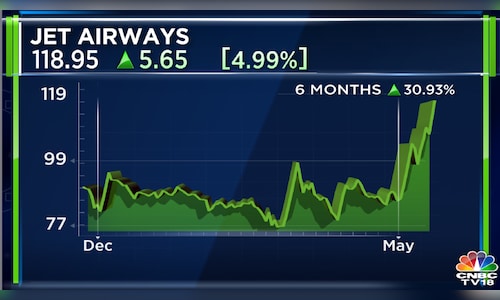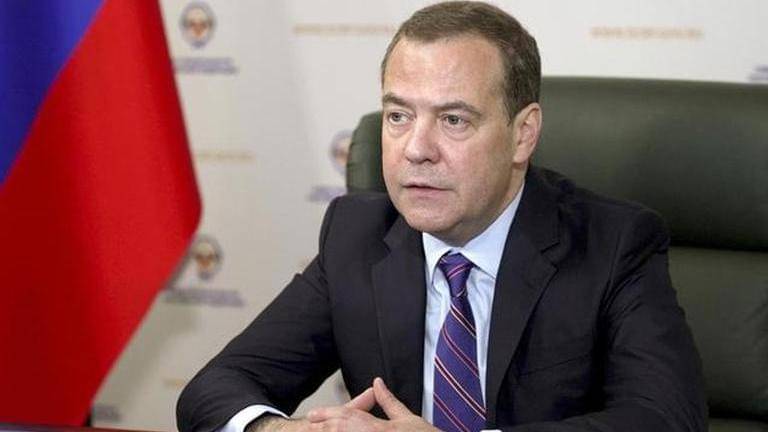
- Select a language for the TTS:
- UK English Female
- UK English Male
- US English Female
- US English Male
- Australian Female
- Australian Male
- Language selected: (auto detect) - EN
Play all audios:
The share price of Jet Airways rose 5 percent on Monday after the airline received its revalidated Air Operator Certificate (AOC) from the Directorate General of Civil Aviation (DGCA) on
Friday. The stock was trading 4.99 percent higher at Rs 118 per share around 12:40 PM on the BSE. The surge in Jet's stock price coincides with Rakesh Jhunjhunwala's Akasa Air
unveiling the picture of its first aircraft. > Coming soon to Your Sky! ✈️#AvGeek pic.twitter.com/nPpR3FMpvg > > — Akasa Air (@AkasaAir) May 23, 2022 The new owners of Jet also
announced the airline's senior leadership team with the appointment of Prabh Sharan Singh as Chief Digital Officer; HR Jagannath as Vice President – Engineering; Mark Turner as Vice
President – Inflight Product and Services and Vishesh Khanna as Vice President – Sales, Distribution, and Customer Engagement. The DGCA granting the AOC to Jet Airways means the airline,
which remained grounded for more than three years, can resume commercial flight operations. The regulator's nod comes after Jet Airways successfully completed all proving flights — the
last step to obtain the AOC for an airline — on May 17. But catching up in a race is hard, let alone overtaking, especially when you are picking yourself up after a fall. Jet Airways, which
is re-entering the aviation industry race after remaining out of it for long, is staring at possibly bigger challenges, now that it has to compete against more and better participants. Jet
is aiming to return to the skies with its new promoters by the next quarter. The Kalrock-Jalan consortium, the new owners of Jet Airways, had recently sought an extension of two months to
revive the air operator's certificate for the airline as it needed more time to complete the regulatory requirements. The deadline to implement the revival plan of Jet had ended on
March 22, forcing the promoters to seek an extension. “There are certain expectations from the Jet brand. We not only intend to live up to those, but do better without compromising on the
warmth, commitment to excellence in customer service, and sheer poise that defines the brand,” CEO Sanjiv Kapoor told CNBC-TV18 last month. While the airline is creating history, being the
first one to be revived after completely ceasing operations, it's not going to be an easy path after resuming services. MORE PLAYERS With Air India already sitting on a pile of debt
then, Jet’s domestic rivals three years ago were primarily Vistara, IndiGo, SpiceJet and Go Air. As the airline resumes services later this year, it is going to be a tougher battle in the
skies, not just with the restored trust in Air India on Tata regaining its ownership, but also due to another player entering the market — which is bad news for the others as well. Ace
investor Jhunjhunwala launching his budget airline Akasa Air is likely to intensify competition in the aviation industry. Akasa, being a budget airline, and as promising as Jhunjhunwala’s
stock recommendations, is expected to disrupt the low-cost carrier market. To retain their market share, airlines, including Jet, will have to roll out discounted prices. Considering Jet’s
likely model, that also includes premium services, it may be already staring at one of its biggest challenges — managing costs in an intense price war. Besides, Akasa may launch operations
as early as in June — before Jet’s comeback— and so have an edge over the latter, because remember, in business, timing is everything. CROWDED INTERNATIONAL SKIES Meanwhile, Air India’s
vision is clear. The airline wants to expand its network, modernise its fleet, improve customer service and become a technologically-advanced carrier, as Chairperson of Tata Group N,
Chandrasekaran said in his first address to the staff. Both Air India and Jet were crippled but what gives the former an upper hand in the game is that it continued to fly though with a life
support system — the government. Air India, working on the efficiency of its existing fleet and with plans to make the most of international operations, is already ahead in the game. Jet,
on the other hand, is initially only focusing on domestic and short-haul international operations. Additionally, IndiGo — which already dominates the domestic market — eyeing international
skies makes Jet’s job of becoming a consistent market leader even more difficult. ATF — A CONSISTENT CONCERN Compounding the woes are the soaring fuel prices. The cost of refuelling for
domestic airlines has gone up to a record high of Rs 1,23,000 per kilolitre with the recent hike of 5 percent. This is a rise of more than 90 percent in a little over a year — from Rs 58,374
per kilolitre in April 2021. Soaring prices of aviation turbine fuel (ATF) have remained one of the biggest concerns for domestic operations, with the rates ranging from 25 percent of total
operational costs for a single-engine aircraft to up to 45 percent for large planes. Jet fuel rates are changed monthly in the country. The Russia-Ukraine war has only made matters worse
for the industry, with the international oil prices seeing a record increase, climbing to a multi-year high recently. “Fuel prices are a huge challenge, but we hope that the price will
subside. Historically, fuel prices have been cyclical, with spikes from shocks caused by global events. It’s a difficult time to be flying, but every airline is dealing with this problem. We
believe that taking a longer-term view, there is white space available for a new, differentiated airline to succeed in India,” Jet CEO Kapoor had said last month. FIGHTING FOR THE REDUCED
PIE IndiGo’s dominance of the market is only growing. In 2018, IndiGo, the industry leader, recorded a market share of 41.5 percent, followed by Jet Airways (13.8 percent), Air India (12.7
percent), SpiceJet (12.3 percent) and GoAir (9 percent). IndiGo’s market share increased to 48.2 percent in 2020, while SpiceJet and GoAir also saw a marginal rise in their market share to
15.6 percent and 10.8 percent, respectively, in the year. Air India’s market share dropped slightly to 10.9 percent during the period. Currently standing with over 50 percent of market
share, IndiGo’s strong grip leaves other players fighting for only the reduced other half of the pie. With the new players entering the market and the existing ones strengthening their
strategies as the industry braces for a post-COVID revival, Jet is bound to face sustained rough weather on its second take-off. ALSO READ | JET AIRWAYS CLOSER TO GETTING ITS WINGS BACK: A
TIMELINE







